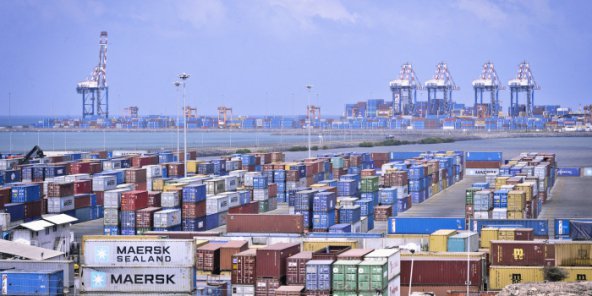The Port of Mombasa is staring at a new threat from South Sudan, with fresh clamour to transfer business to the Djibouti route, in what will deny Kenya revenue on 1.1 million tonnes of cargo that the facility handles annually.
Mombasa has been the main route for all consignments destined to the landlocked country and South Sudan now says Port of Djibouti is shorter.
“We are in talks with Djibouti authorities so that we can connect Djibouti, Ethiopia, and South Sudan to use Djibouti port through Ethiopia,” deputy chairperson for Chamber of Commerce in South Sudan Lado Lukak Legge was quoted saying by the media in Sudan.
“Djibouti is near to South Sudan compared to Mombasa port in Kenya and the government of Djibouti is willing to strengthen trade ties with South Sudan and Ethiopia,” he said.
Foreign Affairs principal secretary Macharia Kamau told Business Daily the push is not yet a concern to Kenya.
The South Sudanese embassy in Nairobi did not respond to our inquiries on the country’s official position on the matter.
South Sudan is second after Uganda in the use of Mombasa port, accounting for 9.9 percent of transit volumes. Uganda accounts for 83 percent of all throughput cargo followed by the Democratic Republic of the Congo, Tanzania and Rwanda at 7.2, 3.2 and 2.4 percent, respectively.
The Kenya Port Authority (KPA) managing director John Mwangemi refused to comment on the matter saying that the port was not aware of the move.
“I cannot comment on that matter, we have not received any communication from South Sudan in regard to that matter,” said Amb Mwangemi.
The shift, if successful, will also hit the newly established dry ports in Naivasha and Nairobi, where cargo destined for South Sudan were supposed to be cleared at the Inland Container Depot (ICD).
Just recently, Kenya and South Sudan agreed to clear cargo destined to Juba in Nairobi starting this month.
In 2019, President Uhuru Kenyatta announced that Kenya would allocate South Sudan 10 acres of land for construction of a dry port at the Naivasha special economic zone. The land, which acted as an incentive to have Juba use Kenya as a transit route for its cargo, was meant to ease the movement of goods to the neighbouring nation.
Kenya and South Sudan have over the years been working towards the completion of transnational highways, including the Eldoret-Lokichoggio-Nadapal-Kapoeta-Torit-Juba Road that would ease the movement of cargo between the two countries.
Kenya has also been fast-tracking the completion of the Lamu Port South Sudan Ethiopia (Lapsset), oil pipeline and the Lamu Port to link the two countries.
This comes at a time some shippers have been avoiding the Northern Corridor, which connects cargo from the port of Mombasa to Juba, Kigali, Kampala as well as DRC, and now shifting their cargo to the Central Corridor.
The Central Corridor, which is 1,300km long, begins at the port of Dar es Salaam and serves Tanzania, Zambia, Rwanda, Burundi, Uganda and Eastern DRC. The northern corridor is 1,700 kilometres long.
The move by DRC to join East African Community (EAC) also poses a threat to the Port of Mombasa as it is slowly shifting the cargo that passes through the northern Corridor to the Central route to Kinshasa.
Dennis Ombok, former chief executive officer of the Kenya Transporters Association, said there are many factors that will determine whether Mombasa will remain relevant to cargo destined to DRC.
“Things like road tolls, transit period and traffic situations are some of the factors that transporters will use to determine the route that they would want to use and Mombasa has to up its game or lose this business to Tanzania,” said Mr Ombok.
Mr Ombok said the incentives at the ports will also play a key role in determining the effective route for transporters.
“Truckers will also be keen on incentives at the ports such as free storage period and lower charges to decide whether to use the port of Dar es Salaam or Mombasa,” he said.
Prior to admission, EAC States had to pay tariffs to either import or export goods to DRC because of the external tariff that was applicable.

